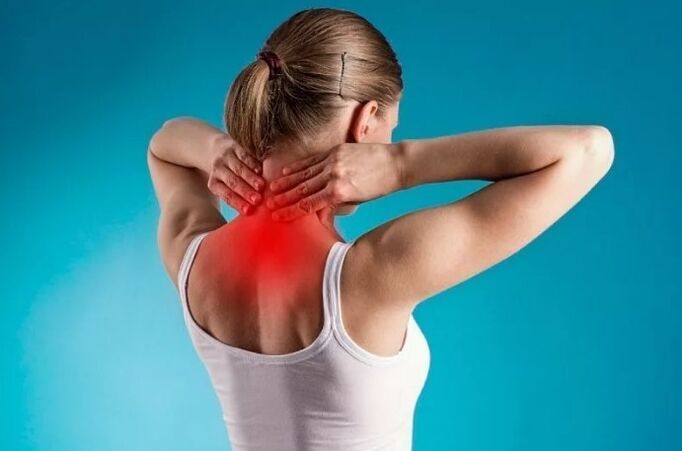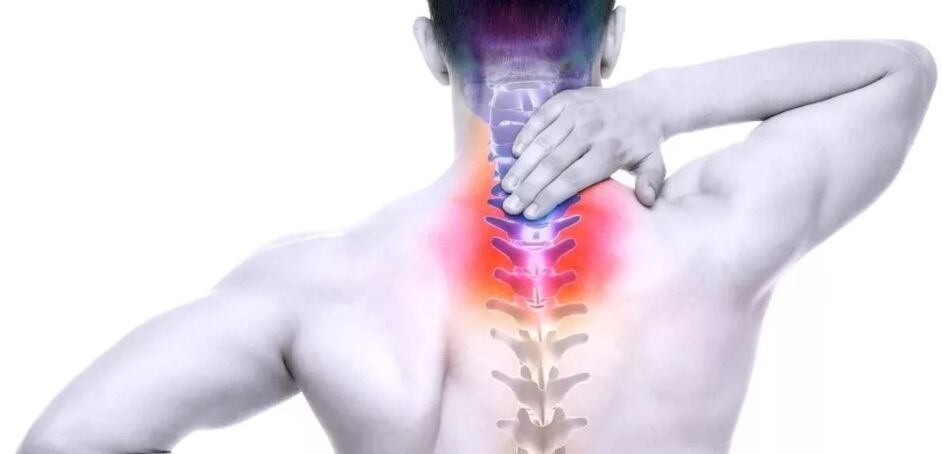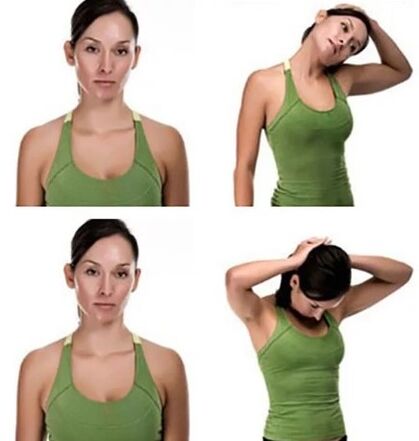Cervical osteochondrosis is the dystrophic and progressive design of intervertebral discs in the area of 1-7 vertebrae belonging to the cervical region.
As a result of cervical osteochondrosis, deformation, exhaustion and damage to vertebral bodies. This interrupts normal blood supply and nerve conducting in the neck and areas that are innervated by the roots of the nerves of the cervical nerves.
Cervical osteochondrosis can be isolated or combined with osteochondrosis of other departments - lumbar and sacral.
Reasons

The causes of dystrophic and degenerative changes in intervertebral discs have not yet been studied. The assumption that osteochondrosis is a senile phenomenon of confirmation. It is found even in children and adolescents.
Several factors that predispose to the development of osteochondros are distinguished. These include:
- Sedomer and sedentary lifestyle,
- Types of work with a static burden on the neck,
- overweight, insufficient physical development,
- Dysplastic processes of connective tissue,
- violation of blood circulation in the neck,
- neck injuries,
- Scoliosis, posture defects, uncomfortable pillows and mattresses,
- Hereditary predisposition, metabolic defects.
Cervical osteochondrosis symptoms
The cervical spine, due to the characteristics of the skeleton, on the right, as well as the large size of the head, is especially vulnerable to the development of osteochondrosis-vertebrae are the smallest compared to other parts of the spine, and muscle structure is not very pronounced.
The most characteristic symptom that patients complain - pain in the cervical region. Depending on the damage zone, the pain can be located
- in the collar and shoulder;
- throughout the cervical spine;
- On the front surface of the chest.
Pain in cervical osteochondrosis is due to the characteristics of the cervical region.
The first signs of cervical osteochondrosis are insignificant and slightly specific:
- The pain in the neck at night,
- weight of weight in the head, headaches in the occipital zone,
- a feeling of numbness or tingling on the shoulders and hands,
- Create around the neck by turning your head by clicking on the vertebrae.

Main symptoms:
Vegetative-district
- Very severe pain in the neck and especially in the area just below the back of the head;
- The pain occurs after a long stay in a position (for example, after sleep);
- The neck muscles are constantly tense;
- There are difficulties with abandoning the hand to the side;
- On the affected side, the fingers are limited in movements.
Since vertebral arteries are compressed, neurological manifestations are observed: headache, nausea, fainting.
Symptom of the spine
The pain is located behind the left.
This type of pain should be distinguished from pain, as in angina pectoris (with angina pectoris, nitroglycerin is relieved with osteochondrosis - no).
With a gradual violation of the structure of intervertebral discs, its compression (compression) occurs and the violation of nerve roots, as well as strengthening or violation of arteries and veins, which occur in the area of vertebral bodies.
This leads to the formation of special - root and ischemic syndromes.
- The defeat of the roots of the first cervical vertebra (C1): violations affect the back of the head, reducing skin sensitivity;
- C2 lesion gives pain in the crown of the crown and behind the head;
- C3 injury gives neck pain on the infraction side, a decrease in language sensitivity and language muscles, in some cases with speech impairment and loss of control over language;
- The defeat of C4 and C5 gives shoulder and clavicle pain, a decrease in the tone of the muscles of the head and neck, sobs, breathing disorders and pain in the heart;
- Defeat C6 is more often, giving pain from the neck to the shoulder blade, forearm, to the thumbs, the sensitivity of the skin may suffer:
- Defeat C7 provides similar neck pain symptoms, the rear of the shoulder, to the back of the hand, violation of hands force and a decrease in reflexes.
Blood circulation disorders due to the compression of the vessels in the area of cervical vertebrae give headaches to migraine, severe dizziness, visual impairment and ears in the ears, tremBilous fly in front of the eyes, disorders of autonomic functions.

There may be manifestations of cardiac syndrome with compressive heart pain, shortness of breath and heartbeat, rhythm disorders.
Complications
Severe complications of cervical osteochondrosis are
- intervertebral disc protrusion with the formation of a hernia (protrusion);
- Intervertebral disc rupture with violation of blood vessels and vessels, it is possible to compress the spinal cord, which can lead to death;
- There may also be radiculopathies (root lesions), the formation of osteophytes (peaks in the vertebrae) with a manifestation of paresis and paralysis.
Diagnosis
In the presence of the above complaints, an appeal to the doctor or orthopedic neurologist is required.
First of all, the doctor will evaluate mobility and neck pain, sensitivity and other functions. Next, it will be necessary to radiography of the cervical spine in various projections, if necessary, computed tomography or magnetic resonance scan with herniated suspicion.
In case of circulatory disorders, reoencephalography and background examination will be required.
Treatment of cervical osteochondrosis
Today there are traditional and non -traditional methods for the treatment of osteochondrosis in the cervical spine.
Conservative methods are mainly used:
- Symptomatic therapy with painkillers to relieve pain syndrome
- Reception of non-starring anti-inflammatory drugs to relieve inflammation and tissue edema
- To eliminate muscle, antispasmodic cramps and medications to improve blood circulation are used.

In the treatment of cervical osteochondrosis, substances that restore the structure of intervertebral discs - chondoprotectors are used.
The course of group B vitamin therapy is shown, external products for therapy are applicable - gels and ointments, creams with anti -inflammatory and painkillers. Show stimulants of intervertebral discs regeneration.
Massage, Acupuncture, Fysiadoction, Physiotherapy and Gymnastics and Gymnastics and Gymnastics help Physioception in the treatment of osteochondrosis. The osteopathy method proved to be well - a light effect on "prey" zones of muscles and vertebrae.
In the treatment of cervical osteochondrosis, the use of a special collar (Shantsa collar) is recommended.
Complications of cervical osteochondrosis with hernias that violate sensitivity and blood circulation can be treated promptly.
The duration of treatment depends on the neglect of the condition, since osteochondrosis is a progressive chronic disease. Treatment can be long and preventive courses are performed for a lifetime.
Proper nutrition will help alleviate the condition of osteochondrosis.
Exercises for the treatment of cervical osteochondrosis:
- Self-Auto-Project: In a position with straight back, it is necessary to lower the shoulders as low as possible, while the neck should be pulled up. At least 10 approaches are required at least 3 times a day.
- Self -Massage: Garnish the neck with a towel, taking it by the tips and pull it alternately, spreading the muscles of the neck. In this case, it is necessary to ensure that the towel does not slip along the neck.
- Gymnastics for the cervical region for osteochondrosis: Small flexion of the neck, as well as turns and head tilt, are shown. Each time, 5-7 inclinations are made in each direction. This exercise is more useful for executing after self -cassage of the cervical spine.
Prevention
The base of the health of the cervical spine is a strong and healthy back, physical activity, a comfortable bed with pillows and anatomical mattresses, proper posture and proper nutrition.
It is worth avoiding neck injuries and weight lifting. It is necessary to combine prolonged sitting with rest and hot periods.























